Steven Pressfield's Blog, page 74
January 8, 2016
Connectin’ Like Hendley

Shady and not as dashing as Hendley, but scroungers with connections, just the same. Image credit: MGM
Luther and Bobby used to put small baggies of paint in the middle of Aiken Road.
The cars flyin’ by would end up splattered, in need of a paint job.
Lucky for them, the body shop Luther’s daddy worked at was just down the road.
This was before Google and Angie’s List — when the Yellow Pages still doubled as booster seats for toddlers and people relied on word-of-mouth recommendations, and/or the closest locations, when choosing contractors, mechanics, restaurants and pretty much everything else.
The two did a fine bit of referral work for Pop, who gave ‘em a cut to keep ‘em incentivized. “Extra honey to keep ‘em happy.”
On the side they had a pest management operation. Before being fired, Bobby stole a few canisters of some sort of spray from his old job. He’d spray the neighbors’ yards at a cut-rate, then Luther would go in and spray sugar water around their houses every few months to get ‘em callin’ Bobby again. Sort of a forced subscription service. “Call when you need me,” Bobby would say. Fortunate for Bobby, they always needed his services when he needed money.
They reminded me of Hendley from The Great Escape — just the shady, not- as-dashing-as-James Garner versions.
They were scroungers with connections. If you needed it, they could get it. And if someone else needed it, you’d best guard it with your life because they’d thieve it back. They could steal a song from a mockingbird just the same as paint from a fence.
I didn’t agree with Luther’s and Bobby’s ways, but they sure did hustle. Rare to catch ‘em playin’ possum. And . . . They were saleman. They could sell sin to a Sunday School teacher.
You could say they were the first guerilla marketers of sorts that I ran into. Again, just the shady sort…
While I distanced myself from them decades ago, I do think back to them quite a bit. Yes, they went to jail. Yes, they couldn’t be trusted. Yes, they’d have your back one day and stab it the next. But . . . They were successful in their own way. Not in a millionaire with a hefty retirement sort of way, but if they had a need — or could benefit from the needs of others — they were good at gettin’ it done.
What it really came down to was that they were always available, always out front — and they were known and referred often. Need something? Call Luther and Bobby (just keep your wallet deep in your front pocket, where it’s harder to pick).
Today, you’d call them “connected,” with a well-developed mailing list of sorts. They kept in touch with “customers” and made sure their services and availability were known.
As I said, I didn’t agree with them, but I learned from them. Those connections and relationships make a difference. I just shoot for the version that’s minus the back-stabbing, thievin’ ways.
January 6, 2016
Make Your Hero Suffer, Part Two
We finished up last week with the idea that our protagonist’s suffering should not be arbitrary or capricious but on-theme.
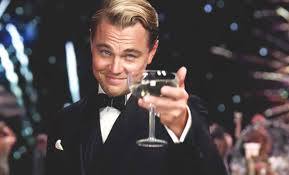
Leo DiCaprio as Jay Gatsby. His suffering was on-theme and profound.
In other words, if Jay Gatsby suffers agonies of rejection by both Daisy and the social class she represents, that suffering is because Gatsby has bought-in so totally to that materialistic, acquisitional (and very American) fantasy himself. If he weren’t so fanatically pursuing the dream represented by the green light on the end of Daisy’s dock, he wouldn’t be suffering so much. And he wouldn’t ultimately be destroyed.
The protagonist embodies the theme. (A case could be made, I know, that Jay Gatsby is not the protagonist of The Great Gatsby, but let’s put that aside for the moment for the sake of argument.)
What, then, about the villain? If the villain represents the counter-theme, how does he or she figure into the hero’s suffering?
The villain should be the cause and generator of the hero’s suffering.
Darth Vader in the first three Star Wars movies serves that function (he and the Emperor).
Noah Cross does the same in Chinatown, as does the Alien in Alien, the Predator in Predator, the shark in Jaws.
I was working on the first Steven Seagal movie, Above the Law, when one of the Lethal Weapon films (I forget which one) came out. In it was a scene where Mel Gibson was tortured by the villain. Steven Seagal saw the movie and came in the next day on fire. “Write me a torture scene!”
I remember thinking at the time, “That is the dumbest, most derivative idea I’ve ever heard.” But of course Steve was right. That type of scene is a convention of the thriller genre, what Shawn calls the “Hero at the Mercy of the Villain” scene. We wrote it for Steve and it played like gangbusters.
The villain should be the source of the hero’s suffering.
But what if the villain is internal? What if the antagonist exists only inside the hero’s head?
Even better.
The villain in The Great Gatsby isn’t Tom Buchanan, brutish and “hulking” as he may be. (I actually like the character of Tom Buchanan; I have a lot of sympathy for him.)
The villain is reality.
The villain is The Way Life Really Works.
“But,” says Nick Carraway to Gatsby, “you can’t recreate the past.”
“Why, of course you can, old sport!”
Let me revise that statement from four lines ago. The villain is Gatsby’s self-delusion, his dream of recapturing a romantic moment and making it live again permanently. A moment, we might add to make it even worse, that was never real, except in Gatsby’s mind, even in the moment it was happening.
Which brings us to another, deeper aspect of the hero’s suffering.
If that suffering must be on-theme, then the more profound and universal the theme, the greater the emotional impact on the reader.
What makes Gatsby’s downfall so resonant (it must be, because the book is still being taught in English classes ninety years after its publication) is that Gatsby’s suffering is so American. His dream is the American dream. You’ve believed it. I’ve believed it. We’ve all operated under its spell our whole lives.
Scott Fitzgerald chased that dream as passionately as any writer ever, and it killed him just as brutally as it killed Gatsby.
That dream is the villain of The Great Gatsby.
It’s a powerful exercise for us as writers to ask ourselves these questions:
Is my hero suffering enough?
What is the source of my hero’s suffering?
Is that suffering on-theme?
What the heck is my theme?
Is my theme big enough? (And the corollary: Does my hero’s suffering resonate powerfully enough with the reader?)
The villain in Erich Maria Remarque’s All Quiet on the Western Front is mindless, bullheaded nationalism. This is embodied by the boys’ teacher, Kantorek. All the suffering of the book’s hero Paul Baumer and his friends derives from that notion and, literally, from Kantorek, who as its passionate proponent urges them to march off to war in the first place.
That’s why the story works so powerfully.
The hero must suffer.
The suffering must be on-theme.
The bigger and more powerful the theme, the greater the suffering—and the greater the emotional impact on the reader.
We’ll talk next week about why suffering is so important in a book or a movie.
January 1, 2016
The Story Behind The “Random House Gives $5,000 Bonuses” Story
Hal Holbrook as Deep Throat “Forget the myths…follow the money.”
[Happy New Year! Here’s an oldie but goodie about how profitable a BIG BOOK SERIES can be and why resisting the impulse to sell yours to a big publisher after it’s a success makes sense…]
For those of us who came of age in the analog universe, the phrase “follow the money” reminds us of a movie that inspired thousands of people to get graduate degrees in Journalism. It comes from William Goldman’s brilliant screenplay adaptation of Bob Woodward and Carl Bernstein’s seminal narrative nonfiction book All the President’s Men , which was published by the venerable Simon & Schuster in 1974.
, which was published by the venerable Simon & Schuster in 1974.
In Alan J. Pakula’s movie, Woodward’s primary source Deep Throat (revealed a few years ago as the FBI’s number two man at the time W. Mark Felt), only agrees to confirm or deny Woodward and Bernstein’s reporting. He won’t hand them the Watergate story on a silver plate. But W&B get stuck. Seeing Woodward’s (played by Robert Redford) desperation, Deep Throat (played by Hal Holbrook) agrees to give Woodward one piece of advice.
He tells Woodward to “forget the myths the media has created . . . follow the money.”
The quote is not in the book. Consummate storyteller William Goldman coined that “follow the money” phrase, not Woodward and Bernstein. As a seasoned Hollywood screenwriter, Goldman knew that putting aside mythology and following the money in his business is always revelatory. By extension, he used money as the through line device for his screenplay about Washington. Can anyone argue today that money is not the operating factor in politics? Back then it wasn’t so obvious.
I’m sure you’ve read the press coverage about Random House Inc. giving each of its 5,343 employees a $5,000 bonus this year. I checked this morning on Google News and over 1,100 stories have been written about their $27,000,000’s worth of good cheer.
How did they afford to do that?
I worked at divisions of Random House (Dell Publishing and Doubleday) and I can tell you that bonuses in my day were often of the “No Christmas party this year but Congratulations . . . you get to keep your job next year!” variety.
Random House was able to pass on some cash to its employees because of the jaw dropping success of the Fifty Shades of Grey trilogy. You already know this story. An online Australian outfit called The Writers Coffee Shop (a long tail eBook and Print on Demand publisher like Black Irish Books) published all three of E.L. James’ erotic novels in 2011. The eBook versions of the books were $9.99 U.S., but the trade paperback editions were a whopping $29.99.
trilogy. You already know this story. An online Australian outfit called The Writers Coffee Shop (a long tail eBook and Print on Demand publisher like Black Irish Books) published all three of E.L. James’ erotic novels in 2011. The eBook versions of the books were $9.99 U.S., but the trade paperback editions were a whopping $29.99.
Just so you know, TWCS wasn’t gouging on the paperback price. Print on Demand publishing is just that . . . one copy at a time, which is not exactly efficient for a big sensational hit. And as the Grey books are all over 500 pages in length, the price per unit POD costs must have been quite high (my estimate would be about $8.00).
As a $29.99 price point yields $15.00 (50%) to the publisher after the retailers take their share, the production costs exceeded the per unit revenue ($8 versus $7). Not so good. While a $7 per unit revenue is nothing to sniff at, maintaining any kind of large inventory for a retailer is a nightmare for a POD book. So the big margin per unit doesn’t pay off all that much for the publisher.
The truth is that there was a lot of demand for the paperback even at that high price point, but the copies just weren’t out there for people to buy. It was a very large lost opportunity.
But the good news was that the word of mouth on the books was sensational and by the spring of 2012, the three books had sold over 250,000 eBooks. The paperback versions however were just dribbing and drabbing along . . . about 7,000 sold per title. It was obvious that something had to be done.
So when the largest English Language publishers in the world came calling in March 2012, Ms. James (a pseudonym for a former British television producer named Erika Leonard) and her agent Valerie Hoskins decided to hear them out. If a big publisher were to take over the production of the paperbacks, the price would surely fall, the availability of the books would be radically improved and thus more people would be able to afford and find them.
The Executive Vice President and Publisher Anne Messitte at Vintage, a paperback division of Random House, made the most compelling argument. So Ms. James decided to sign over the paperback publishing rights to her works to Vintage for that magical phrase…the seven figure advance.
But there was catch. In order to cash the $1,000,000 check, Ms. James would have to sign over not just the paperback rights, but all rights, including eBook rights.
Let me assure you that Vintage did not pull a fast one here. It was not the only publisher interested in the books and I can safely say (although I was in no way privy to any of these negotiations) that every single big six publisher that Ms. James met insisted that she turn over eBook rights—including Random House’s rival Simon & Schuster.
No eBook rights, no deal. It was a line in the sand that none of the Big Six were willing to cross in March 2012 . . . Just 8 and a half months ago. If E.L. James wanted a big six publisher to publish her books, she had to give them her eBooks too.
A case study of the numbers involved with the Fifty Shades trilogy, though, reveals just how expensive it was for Ms. James to agree to these terms. I wonder how many more bestselling self-published writers will be willing to play by them in the future . . . I can guarantee far fewer after other news that was practically ignored by big media from this past Wednesday . . . more on that below.
Here is the math for the Fifty Shades of Grey trilogy.
Estimated total units sold in 2012 (from numerous reports): 35,000,000.
I’m going to assume that 50% of those units were sold as eBooks. My gut is that the percentage of eBooks sold is far higher than that. Early in the heated selling climate just after RH/Vintage took over, Amazon.com reported that the trilogy eBooks were selling at a rate six times as much as the paperbacks. But to be conservative, for the sake of argument let’s just say 17,500,000 eBooks were sold and 17,500,000 physical copies were sold.
How much money did they make for Random House/Vintage versus E.L. James?
Let’s begin by looking at the traditional paperback numbers.
The books sell for $15.95 a unit in paperback. The publisher, Random House/Vintage, sells the books wholesale for 50% off the retail cover price to retailers who in turn sell to consumers. So each book sold brings in approx. $8.00 a unit to Random House/Vintage.
So the total amount of revenue generated by 17,500,000 paperback sold is $140,000,000 (17,500,000 x $8.00).
Now Random House/Vintage had to manufacture, warehouse and ship at least 17,500,000 paperbacks to generate that 140 million of revenue. Let’s say they’ve produced 20,000,000 to account for returns etc. And let’s say it cost Random House/Vintage $2.00 per unit to produce, warehouse and ship them. Their economies of scale probably brought that unit cost way down…under $1.50 I’d assume, but let’s keep $2.00 as our number, again just to be conservative.
The paperback revenue ($140,000,000) minus the $40,000,000 in production, warehousing and shipping costs (20,000,000 copies x $2.00) leaves $100,000,000 of net revenue to Random House.
But Random House/Vintage has to pay the author too. They don’t get to keep all of that pot for themselves.
Now traditional trade paperback royalties are 7.5% of the retail cover price for every copy sold, which would equate to $1.20 per unit copy sold (7.5% of $15.95) taken out of the big pot.
Some big cheeses (big bestselling writers with long track records of success) get royalty escalations after 100,000 units sold…up to 10% of the retail cover price. Again, let’s be crazily conservative and say that E.L. James’ and her agent convinced Random House /Vintage to pay a royalty of 10% of the retail cover price straight instead of 7.5%.
10% of $15.95 is, to make the math easier, $1.60.
$1.60 per unit with 17,500,000 sold throws off $28,000,000 in royalties for paperback sales to E.L. James.
So Random House/Vintage’s conservative net profit on just the sale of 17,500,000 paperbacks is:
(140,000,000-40,000,000-28,000,000)
$72,000,000.
E.L. James’ share is:
$28,000,000.
I’d argue that that distribution of income is fair given the fact that Random House/Vintage dealt with an extraordinary number of variables to bring the books to the marketplace.
But that’s not all of the revenue . . . we now have to look at the revenue generated by eBook sales.
The eBooks retail for $9.99, which is the same price as the original The Writers Coffee Shop version that sold 250,000 units. Random House/Vintage sells the eBook under the agency model and collects 70% of all revenue from the sale of the $9.99 book, or $7.00 a unit. The remaining 30% goes to the retailer.
So the total amount of revenue generated by 17,500,000 eBook copies sold is (17,500,000 x $7.00) $122,500,000.
But for eBook sales, things are even better for Random House/Vintage.
Here’s why.
After you spend at most $1,000 converting a book into the appropriate file formats (kindle and ePub), there are no production costs to produce and sell an eBook. You don’ have to print anything. You don’t have to warehouse anything and you don’t have to ship anything.
So Random House/Vintage’s gross $122,500,000 revenue from the sale of 17,500,000 eBooks is only reduced by the amount of money it cost to convert the files to the appropriate format. Let’s be crazy and say it cost them a half a million dollars to do that for three books that were already in the correct format. That $500,000 will cover the amount of money they needed to spend to employ for a full year the total number of employees who directly contributed to the digitalization, marketing and publicizing of the book.
Remember the publisher has no production costs…no matter what they tell you. Their overhead (what it takes for them to employ people and keep the lights on) is not a production cost!
The standard royalty rate for eBook from the big six publishers is (ahem) 25% of net dollars received. It’s hard not to believe that there is not some sort of gentleman’s agreement among the big six in place about not breaking this barrier. I’m not saying that the six heads got together and shook hands on it. I’m saying that they didn’t have to.
So E.L. James received 25% of $122,000,000 or $30,500,000 of the eBook revenue pool.
Random House/Vintage on the other hand received $91,500,000 of net revenue for that same sale of eBooks.
So the totals for the 35,000,000 copies sold are:
Random House/Vintage: $163,500,000 net profit
E.L. James: $58,500,000 in royalties
Now, let’s add up what Random House/Vintage brought to the table to earn almost 3 times as much money on the sale of E.L. James’ work than she earned.
A new jacket? No. Random House/Vintage wisely used the same cover art that made the books number one bestsellers before they took over the franchise.
New publicity? Not really. All of the publicity generated by Fifty Shades was pretty much in the works before RH/Vintage took over. In fact, all subsequent ink is devoted to how successful the books are more than anything else. I doubt that Vintage had to expend more than 100 hours of a single publicist’s time managing this campaign.
Production & Distribution? Absolutely. This is where Random House did a ton of work. They earned every penny of the $72,000,000 they made from the sale of the paperback editions.
EBook Distribution? No. All online retailers had the eBooks available before RH took over. RH/Vintage did not add any value to the eBooks. They merely embedded the Vintage colophon into the digital editions.
Can an argument be made that without Random House/Vintage the trilogy would not have become the sensation that it became? If there weren’t stacks and stacks of paperbacks at Barnes & Noble, the book would just not have done as well. I think that’s true.
For fun, let’s say we take away 75% of the volume of sale of the trilogy to offset the loss of Random House/Vintage. That is, even though Fifty Shades of Grey was a number one New York Times bestseller without the help of Random House/Vintage, it never hit full throttle velocity and sold just a quarter as well. And because the paperback situation never got sorted out, it only sold in eBook.
So instead of 35,000,000 copies sold, it sold 8,750,000. Only in eBook.
In this case E.L. James would receive $61,250,000. Instead of $1.75 a unit (25% of the $7.00 RH/Vintage received from eBook retailers), she’d receive the full 70% of retail cover price eBook revenue or $7.00 a unit times 8,750,000.
Without doing the deal at RH/Vintage, E.L. James would have made $2,625,000 more selling just 25% of the 35,000,000 she sold with Random House/Vintage. And she would have controlled the price point too.
Can’t everyone win?
Can’t a big traditional publisher get a substantial windfall even when a bestselling self-published author takes home the lion’s share of revenue?
Simon & Schuster thinks so.
I guarantee you that after losing out on the Grey sweepstakes last spring, Simon & Schuster followed the Fifty Shades of Grey math. And they figured out, like we just did, that If E.L. James just sold the physical paperback rights to Random House/Vintage and kept the eBook rights for herself, Random House/Vintage would have made $72,000,000 . . .
$72,000,000 represents an entire year’s worth of profit for a Big Six publisher.
$72,000,000 is even enough to cover generous $5,000 bonuses for 5343 employees (approx $27,000,000) with quite a bit of net profit in to the coffers left over too.
How do I know that Simon & Schuster did this math?
Because they just did a deal with agent Kristin Nelson and her client Hugh Howey. Howey wrote and self published books in yet another bestselling series called Wool . Howey hasn’t sold 250,000 eBooks like E.L. James did on her own though. He’s sold 300,000.
. Howey hasn’t sold 250,000 eBooks like E.L. James did on her own though. He’s sold 300,000.
Simon & Schuster ceded eBook rights entirely to Howey and agreed to just publish hardcover and paperback copies.
You’d think that the 1100 online news sources that covered the generous Random House bonus story would be all over this Hugh Howey story right? I just did another Google search for the Hugh Howey deal and got 36 hits. So no . . . few people understand this development for what it really is.
If you are still fitzing and futzing around telling yourself that you’ll start that anonymous blog about the inner working of the United Nations, that artisanal salad dressing business, that high end wood box manufacturing company or putting off outlining your own post apocalyptic trilogy, I recommend you take a good hard look at Hugh Howey’s business.
Wool is not his first novel. By my count, he wrote and self published seven novels before Wool. Wool was as short story that came to him years after he began his long tail business. He didn’t quit writing when no one cared about his first seven novels (probably more). More impressive, though is that he didn’t sell himself short when they did care either. Being recognized by the big houses was nice, but he wasn’t going to let go of his work just for the third party validation of having a dog on the spine of his books.
He’s a Pro.
I think it’s likely that if he suddenly loses the mojo and Wool tapers off, he’ll still be writing. He can’t help himself. It’s who he is.
This physical copy only deal is a game changer. It’s nothing short of revolutionary.
Think about it. Simon and Schuster didn’t raise the eBook royalty for Hugh Howey from 25% to 30% of net receipts to lure him to do a deal with them. They didn’t even go to 50%. They walked away from eBook entirely.
Why?
There are any number of reasons why S&S did this deal (not the least of which is that CBS is probably in the middle of negotiations with News Corp. to sell them). But one reason makes the most sense. Someone at Simon & Schuster sees the future (I’m pretty sure I know who).
And the future is in the hands of long tail business creators who have the foresight to take the advice “forget the myths . . . follow the money” as seriously as they do their craft.
You.
December 30, 2015
Make Your Hero Suffer
[Down to the last two days of our Black Irish Christmas Special—the 7-Book Megabundle for Writers. Keep a couple for yourself and spread the rest around to “worthy recipients.”]
There’s a story about Elvis:
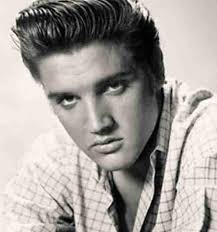
The King instinctively
understood the need for the hero to suffer
He was about to make his first movie (“Love Me Tender”) and he was getting a little nervous. He phoned the director and asked to speak with him privately.
“What is it, Elvis? You look upset. Is there anything you want to ask me?”
“Yes,” said Elvis. “Am I gonna be asked to smile in this movie?”
The director was taken aback. No actor, he said, had ever asked him that question. “Why do ask that, Elvis?”
“I’ve been watching James Dean’s movies and Marlon Brando’s, and I notice they never smile. I don’t wanna smile either.”
Have you ever noticed how the most emotionally involving books and movies all have heroes whom the authors put through hell? Cool Hand Luke, The Grapes of Wrath, The Revenant. Mildred in Mildred Pierce, Sethe in Beloved, even Scarlett O’Hara in Gone With the Wind.
One of my favorite books is The Forgotten Soldier by Guy Sajer. It’s the true story of the German retreat before the Russians on the Eastern front in WWII. Talk about suffering. Yet when friends asked how I liked it, I replied, “I love it.” The more the heroes suffered, the more deeply their travail hooked me.
As writers, you and I may sometimes be tempted to go easy on our protagonists. After all, we like them. They’re our heroes. They may even be thinly-veiled versions of ourselves.
But giving our heroes a break is the most destructive thing we can do.
Instead, pour on the misery. Afflict them like God afflicted Job. Beat them up like Karl Malden did to Brando in One-Eye Jacks or Gene Hackman did to Clint Eastwood (not to mention Morgan Freeman) in Unforgiven. Torture them emtionally like Julianne Moore in Far From Heaven or Still Alice. Break their hearts like Meryl Streep in Out of Africa (or any, or all, of Ms. Streep’s other movies.)
Readers will love it.
Audiences will love it.
Think of your lead character as if he or she were an actor. Actors love to suffer. They win Oscars for it. Daniel Day-Lewis in My Left Foot. Eddie Redmayne in The Theory of Everything.
Luke Skywalker suffers.
Han Solo suffers.
Even James Bond suffers.
The trick to suffering inflicted on the hero, however, is it must be on-theme.
We can’t just piles agonies willy-nilly on our protagonists (though that will work too.) Their ordeal has to be focused. It must resonate with the story’s theme.
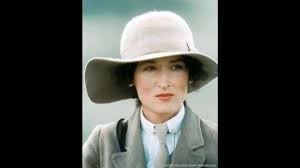
Meryl Streep in “Out of Africa.” The fashion was great, but she still had to suffer
The theme in Out of Africa is personal possession. Meryl Streep as Karen Blixen is obsessed with owning what she loves, as her lover Robert Redford as Denys Finch Hatton teases her in the script by Kurt Luedtke:
ROBERT REDFORD
My Kikuyu. My Limoges. My farm. It’s an awful lot to own, isn’t it?
In the end of course Karen loses everything including Finch Hatton. It works powerfully in the drama because her suffering is on-theme.
The theme in Cool Hand Luke is authority, specifically the authority of society imposed by force. The prison captain, played by Strother Martin, spells it out for the convicts on the road gang:
STROTHER MARTIN
You run one time, you got yourself one set of chains. You run twice you got yourself two sets. You ain’t gonna need no third set, ’cause you gonna get your mind right.
Luke, played by Paul Newman, refuses to get his mind right. All his suffering comes directly from that. That’s what makes it so powerful. It is on-theme.
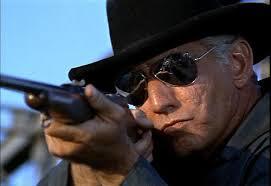
“The Man With No Eyes” draws a bead on Luke
Cool Hand Luke is really the Christ story set in the early 50s in a Florida prison camp. The protagonist, as always, embodies the theme—the refusal to submit to earthly authority—and he, like Jesus, is crucified by the system.
We’ll explore this topic in greater depth next week.
December 25, 2015
The Fat Guy in the Red Suit Knows the Deal
Do you ever feel like a kid at times and wonder how you got here, to this adult place?
Two weeks ago, a friend and I went down that rabbit hole.
A young woman he manages at work is staring down a fork in her road. She doesn’t know what to do next. Wants more money, more responsibility, more of all the usual things…
She looks at him and sees an old guy (anyone over 30 in her eyes). He looks inside and sees a kid. He’s still laughing at the same things he did when he was 12 and his tastes, while they’ve evolved, aren’t too far off 12 either. The same things tend to excite and scare him, too. He’s just better at coping these days. But… When he looks in the mirror… He understands the “old” she sees.
He asked her to stay put for a little while and to learn.
Why?
“You’re just as smart as I am,” he explained. “You could probably do my job. The difference between us that matters isn’t that I’m older or smarter. It is that I’ve done my job and your job.”
In other words, he’s had more opportunities to fail and learn. She sees the success and money. He knows the success came because failures taught him to anticipate pitfalls — and those failures came because he put in the time at various levels to get to the top.
Another example:
I have eleven years of Santa pics with my kids. Ten of them are with the same Santa.
When you look at him, he’s an older guy with a great smile and a beautiful, natural silver beard — the kind that doesn’t come off via a tot’s tug.
There are plenty of older men who could fit the bill, but why don’t they?
There’s more to being Santa than putting on the red suit. Just ask Doris Walker.
A good Santa can accept the transfer of a sleeping baby from her mother’s arms, without waking the slumbering bundle. And: He knows which pose to assume, to delight the mother and all the relatives receiving photo copies. He cradles the baby in one arm, like Barry Sanders with a football, then raises the other arm, to put one finger to his mouth in a shushing motion. He makes eye contact with the photographer, smiling with his eyes instead of his mouth. Happy momma. Sleeping baby. Mission accomplished.
A good Santa knows the basics of kids, too. Want a kid to believe you’re the real deal? Tell her something you’d only know if you were in her house. Tell her to stop fighting with her brothers or sisters and suggest she listen to her parents. Not groundbreaking stuff, but to that four-year old jumping off Santa’s knee, he’s a believer. Somehow that fat guy in the red suit knew he fought with his older brother.
What Santa really knew was the truths of childhood.
He knows because he’s had experience. He’s seen what works and what doesn’t, so that by year ten, he knows how to deal with difficult kids and their often equally difficult parents. He knows how to put people at ease, and can spot a potential meltdown ten families into the line waiting to see him.
He’s just like my friend, but wrapped in a different look. He’s failed and the lessons that arrived fueled future successes.
I hope the young woman my friend is mentoring will stick around. She might get more money somewhere else, but the experiences and guidance she’ll gain working with him have greater value.
She doesn’t have to be an elf forever, but if she wants to aim for a red suit of her own, she needs to put in the time.
My friend, and I think Santa, too, would tell her they’re still young at heart, feeling very much the kid. That thing making them adults — and allowing them to succeed — isn’t age. It is experience.
Money pays the bills, but experience will be a better guide than money the next time she finds herself facing a fork in her road.
December 23, 2015
“Think of This Movie as a Sausage”
[Don’t forget the huge savings on our Black Irish Christmas Special—the 7-Book Megabundle for Writers. Keep a couple for yourself and spread the rest around to “worthy recipients.”]
A few years ago I was working on a “B”-movie at Warner Bros. There was a car chase in the script, and the director, who was young and on fire to do something really special, came up with an idea that he thought would take that scene from good to great. He went to the office of the Warners’ exec who was in charge of the production (and thus controlled the budget) and made an impassioned, on-his-feet plea for an extra X thousand bucks, just to make that one scene a showstopper.

Anne Hathaway, the original.
The exec listened patiently without saying a word. Then he stood, crossed to the director, put his arm around his shoulder and said, “Bruce, think of this movie as a sausage. It’s just another link and you’re grinding it out.”
(This is all totally true, by the way).
At the time I remember thinking, “This is Hollywood moviemaking at its cheapest, laziest, most cynical worst.” I was outraged.
But a few days later I got to thinking, “You know, the exec is right. This movie is just a sausage, and we are just grinding it out.”
On the other hand, I like sausages.
Why not make a good sausage?
Why not make a great sausage?
Whaddaya think? Was War and Peace a sausage? Was Hamlet?
On the one hand, they definitely were. Both were hard slogs, long grinds. Both required serious, workmanlike patience and tenacity. I don’t know this for a fact, but I’ll bet Will Shakespeare was working at the Old Globe with a producer/financier whose point of view was not far off from that of our exec at Warners. He, the Bard, was probably writing two or three other plays simultaneously, pitching three or four more at the Royal Court and the Dramatists’ Guild, while fending off Edward de Vere, the Earl of Oxford, who was challenging his authorship (along with Sir Francis Bacon, Christopher Marlowe, and William Stanley, the Earl of Derby), all the while operating on four hours of sleep, not to mention dealing with crazy actors, late payments of royalties, his landlord clamoring for the rent, the tax collector seeking overdue imposts, while trying to maintain a harmonious relationship with Anne Hathaway (the original one), his wife.
I can picture Will, dashing from a rehearsal or a table read of his next comedy back to his cubby at home so he could return to work grinding out Hamlet. Hamlet was Shakespeare’s twenty-second play. It came between Twelfth Night and The Merry Wives of Windsor. Was there an evening when the playwright smashed his quill pen into his writing desk and, gnashing his teeth, troubled deaf heaven with this bootless cry: “Damme! This sausage is killing me! Forsooth, lemme just grind it out and get it done with!”
What I’m trying to say is, in the end, I came very much to appreciate our Warner exec’s point of view.
Of course we’re gonna work hard on our next book/movie/startup.
Of course we’re gonna beat our brains out to make our stuff great.
Of course we’ll obsess. Of course we’ll go OCD. Of course we’ll drive everyone around us crazy.
But maybe it’s okay once in a while to pause and remember, “It is only a sausage and we are just grinding it out.”
In the end, I hear, we’re all gonna be sausage. So maybe hanging onto a sense of humor is a happy antidote to preciousness and to taking our work and ourselves too seriously.
P.S. the executive in this story (I’ll spare him the embarrassment of naming him) had done a number of good movies before the one we were working on, and he went on (he’s still going strong) to do other seriously excellent films afterward. He was, and is, by no means a frivolous player or a hack.
Maybe he understood something that the rest of us didn’t.
December 18, 2015
Cheat Sheet
Not that long ago I asked an acquaintance to cut an hour out of his day so that I could “run something by him.”

Franklin Leonard, Founder of The Black List, https://blcklst.com/
It’s important to point out that this acquaintance had a laundry list of accomplishments parallel to my own ambitions. He was a bestselling writer, a bestselling publisher, and a world-renowned speaker paid big bucks for the very hour I asked of him.
He is someone any of us would put in our top five of inwardly powerful people who’d figured out the secrets of how to live an authentic, generous life while also having a nice lifestyle too.
Hey, I wasn’t some slouch either. I had some serious successes and failures behind me as well. I wasn’t some amateur looking for an easy street. I had a fully fleshed out idea and just wanted to get his take on it.
At least that’s what I’d told myself.
You see I was so invested in my own world and my own desires that I couldn’t recognize the serious desperation underneath my ask.
I didn’t really want his “take” on my idea. I mean, “duh.”
What I wanted was for him to give me a cheat sheet. I wanted him to tell me how to attract an audience, and then manipulate that audience to do what I wanted them to do…buy my shit and come back for more.
What were the tricks to do that kind of thing? Obviously, this guy knew how to do that or I wouldn’t be traveling forty five minutes up the Saw Mill River Parkway…
He patiently listened to my idea, which I thought had great potential. Still do.
Hell, here it is. It’s no good sitting on my hard drive:
The Book Black List Pre-Origin Story
So after my thirty-minute spiel about my concept of a “Book Black List” and becoming the publisher dedicated to building one, the powerful acquaintance was quiet for about thirty seconds.
That doesn’t sound all that long a time, but just sit quietly for thirty seconds right now and you’ll see that it’s an eternity between two people.
When he finally spoke, here’s what he said:
“It’s a good idea. With dedication and enough time and money to buy a few breaks, it will work.”
That’s all? That’s it? That’s all this genius had to tell me?
I pushed him a bit… Well, if you were to start up something like that, how would you do it?
“How I would do it isn’t going to help you. I would not build that company because there are other projects in my life that I find more interesting. If this idea consumes you, I say plunge right in…but there is one question I’d ask of yourself before you jump… Why do you want to do it?”
I rattled off the usual “angry young man” responses (even though my youth had been spent tilting at a not too dissimilar windmill)…
To right injustices
To prove that the Gatekeepers are frauds
To expose the soullessness of corporate publishing
To make money in order to do “good”
He nodded and smiled and told me that unfortunately our time was up. As he walked me to the door, we shook hands and he said good luck and all the rest of the stuff you say.
As I stood uncomfortably waiting for the elevator, picking at a cuticle, he oddly stayed in the doorway leaning on the unhinged frame.
The arrival ding came and as I walked into the box I hear him say,
“What if you were given the permission not to have to right injustices or prove anyone wrong or build up a pile of money to do good? What would you do then?”
December 16, 2015
Hardest Stuff First
[Don’t forget the huge savings on our Black Irish Christmas Special—the 7-Book Megabundle for Writers. Keep a couple for yourself and spread the rest around to “worthy recipients.”]
When I was in my twenties one of the ways I kept body and soul together was moving furniture. The first thing that experienced movers will tell a rookie is Take the Heaviest Stuff First. Why? Because if you wait till mid-afternoon before tackling that grand piano, you’ll be so tired you won’t be able to handle the weight and the cumbersomeness.

Move this first.
I have the same rule for writing.
Attack the hardest parts first.
What that means is that I don’t work on a story in sequence. I don’t start on Page One and push straight through to The End.
Here’s how I do it:
I’ll start with a Foolscap (a one-page snapshot of the whole work) and a broad-strokes outline (I usually name the file “Three Act Structure”) and I’ll add a more detailed Scene by Scene (sorta) outline. So I know where I’m going and the general contour of how I intend to get there.
But from there, I’ll work wildly out of order.
For instance, if I were writing Moby Dick, I might start with the climactic battle between the White Whale and the Pequod, just because it’s the hardest.
Why do it that way?
Because once I’ve broken the back of that daunting sequence, I feel tremendously relieved knowing that that make-or-break part of the story can be done, even if I haven’t got it exactly the way I want it yet.
Serendipity and happy accidents. I often find that when I tackle the hardest stuff first, really interesting ideas or plot twists or character notions will “pop out” spontaneously in the heat of the writing. This makes sense, because the toughest scenes will naturally hold the most difficult moments, story-wise and character-wise. (That’s why they’re tough.)
The third reason for working this way is it’s the strongest posture to take against Resistance. Resistance wants us to piddle around on the margins and take on the easy stuff first. We get soft that way. Our resolve is not fortified by the way we’re working but attenuated by it. Always hanging over our head is the knowledge that we have to confront that Big Tough Scene sooner or later—and that we’ve allowed ourselves to be daunted by it so far.
Setups and Payoffs. In a way, tackling the hardest stuff first is a subset of the principle, used all the time by screenwriters, of Start At The End.
The climax is likely to be the most difficult part of the story. Our own laziness and Resistance will make us want to put off facing it. “I’ll get to it when I get to it.”
But if we can lick it first, we can see (or discover spontaneously as we write it) what all, or most of, the payoffs of the story are.
If we know, for example, that Ishmael is going to be the sole survivor of the final battle (payoff), we can work backward and built into the story the instrument of his salvation— Queequeg’s airtight coffin, fabricated earlier by the ship’s carpenter, which bobs to the surface after the sinking of the Pequod (setup.)
But how will Ishmael survive (payoff), clinging in the middle of the Pacific to that fragile little ark? Ah, let’s have the Pequod encounter another whaling vessel, the Rachel, just before the final battle with Moby Dick (setup). And we’ll have the Rachel searching for a man overboard, the captain’s son (setup). That’s how she happens to be prowling the waters when she comes upon Ishmael (payoff.)
In terms of fatigue, the writing of a long-form project may not seem to be an exact analogy to moving furniture. On a writing job you’re working over a period of months or years, not a single day. But as anyone who’s done it can attest, you can get pretty damn tired working on a book. Six months in, or sixteen months, you can be weary to the bone.
Move that Steinway grand first, while you’ve still got the strength.

And use a dolly!
December 11, 2015
When Do You Walk Away?
Don’t forget the huge savings on Black Irish Books’ Christmas Special—the 7-Book Megabundle for Writers. Keep a couple for yourself and spread the rest around to “worthy recipients.”
* * * * *

You know the path will end. Do you cut your losses, drag out the end or change direction?
Kate’s manuscript has been sitting with her editor for over a year. Between submitting it then and waiting for its acceptance now, she’s worked odd jobs to bring in money, writing in between gigs. As she waits, so does the book her gut thinks will allow her to quit the odd jobs and move toward writing full time.
She wants to pull the book, to stop the stall, but there’s that question: What if no one else wants the book? What if it isn’t as good as she thinks it is? Or, if she does believe in the book, can she publish it herself? And promote it? And sell it? Stick around for the stall or try to pull the book from the editor and move in a different direction? The first feels safe — and frustrating. The second is scary — but would create movement.
Jake works with young musicians. He has an eye for talent and a knack for spreading “the word,” but a recent project grew so fast that he brought on someone who had more contacts within the upper echelons of the top records companies. Everything looked good for a while, until he found out the business partner was making deals behind his back. The deals were good for the young musicians, but could result in him being cut out.
Should he continue moving forward, hoping that the musicians will see his value and choose him if one day it comes down to a choice — Jake or the business partner? The latter has more high-level connections and could advance the musicians’ careers at a faster pace, but Jake is the one with the passion. He’s the one who found the band — the one who believed in them and got them to that “next level” of being in a position to garner the interest of those industry decision makers that the business partner is pulling in.
If he was in the band, he knows he’d want to stick with the person who found him, but… They are young and hungry… Looking at how young musicians have acted in the past, there’s a good chance that he’ll be on the losing end. Should he cut his losses now? Or keep investing time and stick in as long as possible? Cling to hope? Maybe it will work out, though the mouth guards he’s mangled, grinding in his sleep, make him think otherwise.
Ashley has a client she adores. Every day she thinks about how lucky she is — how amazing it is that she has the opportunity she has. And, it is an opportunity because she learns and grows with the client, in addition to helping the client do the same. The client is the co-owner of a company. Ashley gets along with everyone in the company, with the exception of the relative, who is also a co-owner. The relative doesn’t want to change and spends each day knocking down Ashley’s ideas — the Hell to Ashley’s Heaven.
Ashley begins to realize that her work is all for naught. She’s doing her portion, but the results for the client are minimal. Why? Ashley is advocating change and unless the work she’s doing is implemented and advice acted upon, the client won’t advance. Around the same time the client’s relative starts complaining about Ashley, stating that Ashley hasn’t offered value. The writing is on the wall. Should Ashley stick with the client and company she adores or say goodbye because, end of day, the relative’s decisions rule the day and the relative is not going to change?
Two times in my career, I’ve had to walk away from projects in which I’d invested my heart in addition to my time. Painful. And, saying I walked away isn’t actually right. The clients ended the projects both times.
For the first one, as in the example of Jake, in the above, I vowed to take over the project and do it on my own. I saw the potential. I knew I could make it work. And then… There was the money issue. I accepted more work, which meant less free time, which meant the project I loved and wanted to continue when the client lost interest stalled.
In both instances, there was a decision-maker who resisted change. Though my clients, the ones who signed the contracts, were the key contacts, they weren’t the end-all-be-all decisionmakers within their companies. The clients wanted to move forward, but the decisionmakers had different plans. Looking back, I knew “it” was coming both times, but I didn’t want to stop because I loved the work. I put more heart in, hoping for the best, while my gut twisted, keeping me up at night, knowing what the future held. Easier to ignore it than make the break early. Instead, the break was made by the clients and hurt a hell of a lot more.
I read an article about George Lucas recently, which hit on his sale of LucasFilms to Disney and and the fact that he didn’t play a role in the development of the about-to-be released new film in the Star Wars series (other than, ahem, being the father of the franchise).
“I call it like a divorce,” Lucas says candidly. He always knew that at some point he’d have to part with “Star Wars” in order for the franchise to go on living.
“There is no such thing as working over someone’s shoulder,” he says. “You’re either the dictator or you’re not. And to do that would never work, so I said ‘I’m going to get divorced.’ . . . I knew that I couldn’t be involved. All I’d do is make them miserable. I’d make myself miserable. It would probably ruin a vision — J.J. has a vision, and it’s his vision.”
Lucas’ experience wasn’t quite the same as mine or Kate’s, Jake’s or Ashley’s experiences, but it reminded me of them.
At some point, most of us are faced with walking away.
Do we continue on the same path, even though we know it dead-ends in a cemetery?
Do we cut away at the entrance gate? Or stick around to help dig our own grave?
My vote is cut out before hitting the dead end. Easier said than done…
December 9, 2015
Russell Wilson’s Bird
[Don’t forget the huge savings on our Black Irish Christmas Special—the 7-Book Megabundle for Writers. Keep a couple for yourself and spread the rest around to “worthy recipients.”]
This is gonna be a different kind of post today. I want to talk about a TV commercial.
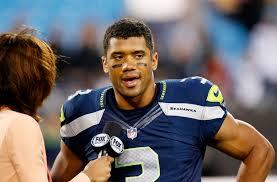
Russell Wilson of the Seattle Seahawks
Why?
First, because this 30-second spot is in my opinion a legitimate work of art. I’ll go so far as to say it’s outstanding art.
Second, because this commercial (it’s really a mini-movie) is a brilliant depiction of the Artist’s Inner World. It doesn’t intend to be, but it is. It’s your world and it’s mine. That’s why I want to examine it in this post.
First, here’s the commercial:
One point before we go further: I don’t care about the fact that this piece of film is trying to sell Bose headphones. That aspect works the least well. Forget about it. We’ll focus only on the mini-movie that comprises the first twenty-three seconds.
Let’s break it down like we would a movie or a novel:
Protagonist.
The hero of the piece is Russell Wilson.
Russell Wilson is the real-life quarterback of the Seattle Seahawks. He led his team to a Superbowl victory two years ago and would have repeated last year except for a final-second interception.
Russell Wilson is a winner. An article in Fanpost made the case that his first three years are the best in NFL history. But Russell Wilson is a very specific type of winner. Russell Wilson was overlooked coming out of college in the 2012 NFL draft. He was picked in the third round, 75th overall. That is late late late. Five other quarterbacks were drafted ahead of him.
The rap on Russell Wilson was that he was not tall enough to succeed in professional football. At 5’11” (most of today’s QBs are 6’3″ minimum with 6’5″ being the ideal height that teams want), how could he see and throw over towering opposing linemen?
But Russell Wilson had big intangibles. He had guts. He had brains, he had passion. And he had a tremendous mental toughness, work ethic and belief in himself.
What separates Russell Wilson from the competition is what goes on in his head. His inner dialogue. He’s a samurai. He’s Musashi Miyamoto. He’s the warrior athlete par excellence.
These aspects of Russell Wilson’s persona are crucial to what makes this mini-movie work. And they’re why, in my mind, Russell Wilson is the avatar of the Artist.
Okay, that’s our hero.
Narrative device.
The voice and point of view of this commercial belong to the other on-screen actor, played by the Seattle rapper Macklemore. (We don’t have to know it’s Macklemore for this film to work; in fact I didn’t know it when I first saw it.) This character speaks all the dialogue except the final line.

“And this? Russell Wilson air.”
A fleeting form passes overhead.
TRICKSTER
You see that?
The Trickster points. The camera follows. A bird lights on a fountain across the pool from where Russell Wilson is sitting.
TRICKSTER
Whose bird is that?
Act Three. (Payoff.)
Russell Wilson sees the bird too. (Somehow a set of Bose headphones has materialized over Russell Wilson’s ears.)
RUSSELL WILSON
(still deep in his own inner world)
That’s Russell Wilson’s bird.
The camera angle now includes Russell Wilson, still sitting on the edge of the pool with his feet dangling in the water—and Macklemore, still standing chest-deep in the pool about twenty feet away.
Macklemore vanishes.
Russell Wilson’s head continues to bob rhythmically, apparently to the music he’s hearing through his headphones (or, more exactly, to his own interior dialogue as he psychs himself up for a coming game.)
Theme.
What is this 23-second movie about?
It’s about the psychic gravitational field set up by an individual’s interior focus, intention, and will.
Russell Wilson is that individual. We don’t (and can’t) know what specific thoughts are going through his head. But through the Trickster’s commentary and our own observation and intuition we can acquire a rough idea.
One, he is a “bad man.” Meaning effective, powerful … a dangerous dude to go up against.
Two, his intention is clearly on some performance he must give in the immediate future. A football game almost certainly. He is turning up the interior juice, psyching himself to play at a level of will and intensity that will produce victory.
Why do I say that Russell Wilson (or at least “Russell Wilson” as depicted in this 23-second movie) is the avatar of the Artist?
Because the mindset he demonstrates is exactly the one that you and I want for ourselves.
And because the effect it produces is precisely what you and I are aiming for as we prepare ourselves to work.
I’m speaking of the psychic gravitational field.
True, the commercial (and the Trickster) are spoofing this and themselves. They get the joke. The film is knowing and wry. The filmmakers see how irrational and woo-woo this stuff appears.
But at the same time they are depicting reality—the reality you and I as artists inhabit every day, just as athletes and warriors and theoretical physicists do—and they know it.
Is that bird really “Russell Wilson’s bird?” Preposterous, right? That bird has no clue who Russell Wilson is and couldn’t care less if he did.
And yet …
And yet, if we believe that animals, particularly wild creatures, are tuned in directly to the Divine Ground, to instinct, to intuition, to vibrational fields such as birds and butterflies navigate by or human emotional fields that dogs can feel and sense, then who’s to say that that free bird, flying by, didn’t on some level pick up the vibes of focus, intention, dedication (and of purity) radiating from Russell Wilson—and decide that he wanted to bask in their aura for a moment, just like he would in a cheerful pocket of sunshine?
Who is that bird?
That bird is your novel. It’s your dissertation, it’s your TED talk, it’s the plans for your new startup.
You drew that bird to you by the psychic gravitational field you set up, powered by your will, your intention, your focus, and your dedication.
The Trickster speaks in jests and riddles, but only because he speaks the truth.
That isn’t just Russell Wilson’s bird.
It’s yours.



